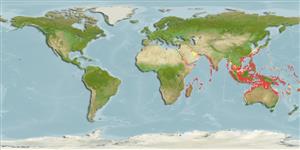分类 / Names
俗名 | 同种异名 | Catalog of Fishes(属, 种) | ITIS | CoL | WoRMS | Cloffa
Environment: milieu / climate zone / depth range / distribution range
生态学
海洋 礁区鱼类; 深度上下限 2 - 65 m (Ref. 9710). 热带; 35°N - 35°S, 26°E - 180°E (Ref. 5222)
Indo-Pacific: East Africa south to East London, South Africa and east to Fiji. Recently recorded from Tonga (Ref. 53797). It is not known from the Red Sea, but it does occur in the Persian Gulf. Record from northwestern Australia (Ref. 3132) is doubtful. It is closely related to, and is often confused with, three other white-spotted species: Epinephelus ongus, Epinephelus summana, and Epinephelus corallicola.
印度-太平洋: 东非南至南非的东伦敦而且东至斐济。 最近从东加记录。 (参考文献 53797) 此鱼种不知道是否来自红海,但是它确实出现在波斯湾。 来自澳洲西北部 (参考文献 3132) 的记录是可疑的。 它是与,亲源相近而且时常互相混淆, 三个其他的白色-有斑点的种: 纹波斑鱼〔Epinephelus ongus〕 , 白星石斑鱼〔Epinephelus summana〕 与 黑驳石斑鱼〔Epinephelus corallicola〕 .
Length at first maturity / 大小 / 重量 / 年龄
Maturity: Lm ?, range 42 - ? cm
Max length : 76.0 cm TL 雄鱼/尚未辨别雌雄; (Ref. 6492)
背棘 (总数) : 11; 背的软条 (总数) : 15 - 17; 臀棘: 3; 臀鳍软条: 8. This species is distinguished by the following characters: body depth distinctly less than head length, 2.9-3.4 in SL (for specimens 11-47 cm SL); head length 2.3-2.5 in SL; head pointed, dorsal profile almost straight; preopercle rounded, finely serrate; opercular spines inconspicuous; upper edge of operculum straight, sinuous or slightly convex; maxilla naked, mostly covered by upper lip; small or absent canines at front of jaws; midlateral part of lower jaw with 3-5 rows of small teeth; gill rakers of first gill arch 8-10 + 13-17 in juveniles and 4-8 in upper limb for adults larger than 25 cm SL; adults with ctenoid scales on body in broad zone along middle of side, cycloid elsewhere and with numerous auxiliary scales; caudal fin rounded; pectoral fins large and fleshy, with 17-19 rays, the fin length 1.5-2.1 in HL; short pelvic fins, not reaching anus, 2.0-2.7 in head length. Colour of adults brownish grey, the body covered with small pale spots overlain with large pale blotches; oblique black saddle on rear half of peduncle; 4-5 indistinct black blotches at base of dorsal fin; prominent black streak on maxillary groove; large adults brownish, covered with small, indistinct, contiguous pale spots; juveniles (less than 25 cm) dark grey to black, covered with prominent pupil-size white spots and smaller white dots (Ref. 39231, 89707, 90102).
Occurs in rocky or coral-rich areas of deep lagoons, channels and outer reef slopes; usually in or near caves (Ref. 089707). Solitary (Ref 90102). Juveniles are found in tide pools. Feeds on fish and crustaceans (Ref. 6113). In Hong Kong live fish markets (Ref. 27253). Caught with hook-and-line, spear, and in traps and probably of some importance to fisheries in areas where it is common (Ref. 39231).
出现于深泻湖,峡道与外礁斜坡的岩石或珊瑚礁繁盛区域; 通常在洞穴里面或附近。 稚鱼被发现于潮池。 吃鱼与甲壳动物。 (参考文献 6113) 在香港活鱼贩售。 (参考文献 27253)
Life cycle and mating behavior
成熟度 | 繁殖 | 产卵场 | 卵 | 孕卵数 | 仔鱼
印度-太平洋: 东非南至南非的东伦敦而且东至斐济。 最近从东加记录。 (参考文献 53797) 此鱼种不知道是否来自红海,但是它确实出现在波斯湾。 来自澳洲西北部 (参考文献 3132) 的记录是可疑的。 它是与,亲源相近而且时常互相混淆, 三个其他的白色-有斑点的种: 纹波斑鱼〔Epinephelus ongus〕 , 白星石斑鱼〔Epinephelus summana〕 与 黑驳石斑鱼〔Epinephelus corallicola〕 .
Heemstra, P.C. and J.E. Randall, 1993. FAO Species Catalogue. Vol. 16. Groupers of the world (family Serranidae, subfamily Epinephelinae). An annotated and illustrated catalogue of the grouper, rockcod, hind, coral grouper and lyretail species known to date. Rome: FAO. FAO Fish. Synop. 125(16):382 p. (Ref. 5222)
世界自然保护联盟红皮书 (Ref. 130435: Version 2024-1)
人类利用
渔业: 低经济
工具
特别资料
下载 XML
网络资源
Estimates based on models
Preferred temperature (Ref.
123201): 24.6 - 29, mean 28 °C (based on 1234 cells).
Phylogenetic diversity index (Ref.
82804): PD
50 = 0.5000 [Uniqueness, from 0.5 = low to 2.0 = high].
Bayesian length-weight: a=0.01122 (0.00702 - 0.01794), b=3.00 (2.87 - 3.13), in cm total length, based on LWR estimates for this species & Genus-body shape (Ref.
93245).
营养阶层 (Ref.
69278): 3.7 ±0.5 se; based on diet studies.
回复力 (Ref.
120179): 低的, 最小族群倍增时间4.5 - 14 年 (Preliminary K or Fecundity.).
Fishing Vulnerability (Ref.
59153): Moderate to high vulnerability (50 of 100).
Climate Vulnerability (Ref.
125649): High to very high vulnerability (66 of 100).
Nutrients (Ref.
124155): Calcium = 21.4 [10.4, 48.2] mg/100g; Iron = 0.447 [0.241, 0.902] mg/100g; Protein = 18.5 [16.9, 19.9] %; Omega3 = 0.112 [0.069, 0.178] g/100g; Selenium = 39 [23, 70] μg/100g; VitaminA = 150 [42, 536] μg/100g; Zinc = 1.24 [0.87, 1.72] mg/100g (wet weight);
